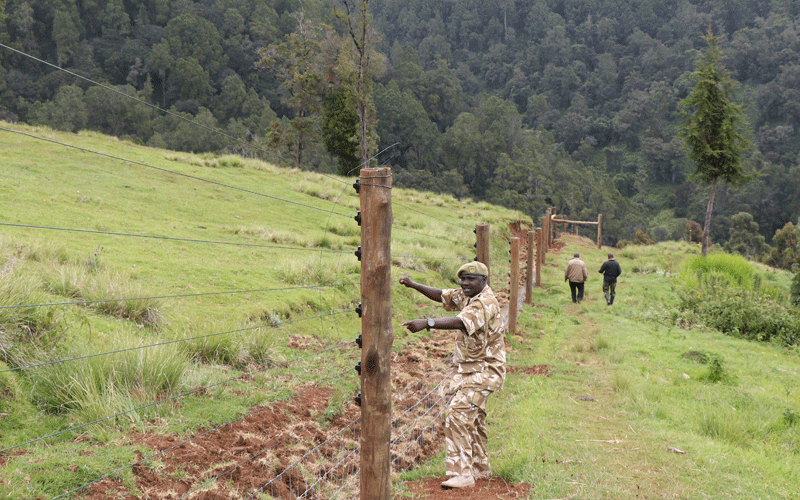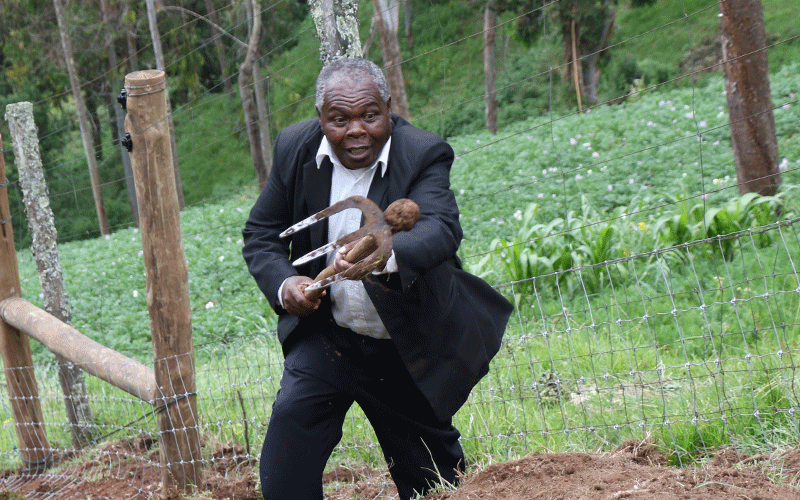How fencing Aberdare forest changed lives

Kenna Claude
Almost crashed by poverty, Maina Kibuka, a conservationist popularly referred to as the “fence man” by fellow villagers, saw education as the only brake to eject him from cycles of misery that had engulfed not only his family, but also the neighbouring community.
Food was supposed to be in plenty on the rich slopes of Aberdare Hills, courtesy of prevailing climatic conditions and fertile soils. But that wasn’t the case.
Wild animals from the forest were not only a threat to their lives, but also to farm produce.
Limited with the number of options they would consider, most parents locked up their children at home so they could venture out to their respective farms, to not only plough, but also guard from wild animals.
“My first experience of education was just empty books since my mother did not want to hear the word ‘school’.
With wild animals hanging around us, it was a permanent no. We lived in constant fear of being attacked by elephants and buffalos,” says Kibuka.
Attacks were a routine; the difference was whether it was a herd of elephants or buffalos, with the latter being the most dangerous, even game wardens exercised caution when approaching them.
Instead of enrolling children at the age of seven in schools, parents waited until the children turned 14 years old.
“With the nearest school located between 10 and 15 kilometres away, it was too dangerous for children aged of five to 12 to walk on their own to and from school.
Therefore, my age mates and I had to wait until the ages of 12 upwards to enrol into schools,” says Kibuka.
Parents knew in case of an attack their older teens would be able to make a wise decision and avoid danger. This situation prevailed until 1989, when the charitable conservation institution, Rhino Ark, heard their cry.

Despite many doubts raised in the initial stages, as the current senior warden of Aberdares, Collins Omondi, testifies, the project sought to secure the first 38km at the salient area of the national park. The total area fenced is 400km and was completed in 2009.
Doubting Thomases claimed the fencing project was a pioneer plan in the country and had not been tried or tested before.
Many raised questions over the possibility of keeping migratory animals enclosed without affecting ecosystems?
Fortunately, no one heeded them and the project commenced. The results were instant, reported cases of human-wildlife conflict were minimal.
Skyrocketing value
“Annually, we used to handle between 20 and 30 cases of deaths as a result of wildlife attacks in the salient region alone, to date, they are almost down to zero,” says a confident Omondi.
Compensation paid to family members by the government as a result of a death caused by animals is Sh5 million and less than Sh2 million for injuries.
Incidents of poaching the critically endangered black rhinos and elephants, which were also a headache and is still a major challenge to the Kenya Wildlife Service (KWS), are on the decline. Illegal logging of cedar trees was also a common trend in the forest.
To the community, results of fencing were immediate. Small-scale farmers started thriving because both their lives and farm produce were secured.
For 58-year-old Kibuka, who has lived in the area for the last 27 years, the security has enabled residents to construct 38 additional schools to the initial two.
With a favourable climate and rich agricultural soil, land value skyrocketed in the area, mostly in Kieni West, where they currently practise mixed farming.
Among crops cultivated are maize, potatoes, beans, carrots, and vegetables. Regions that have benefitted from the protection of Aberdare Ranges water catchment area through reforestation include Nyandarua, Nyeri, parts of Kiambu, Murang’a and down to the low-lying regions of Tana River.
Rugged smartphones
Omondi says for the last 30 years, the ranges have witnessed a forest increase of 20 per cent.
Rhino Ark notes they have been forced to innovate their defense systems, due to the threat of poaching still hanging around because of rising demand for wildlife trophies in international market and game meat among the local community, plus wild animals adopting new way to survive.
Executive director, Christian Lambrechts, says they introduced, “A fence monitoring system that sends text messages in real-time.
Based on the duration of the outage, we can determine whether it is human, animals or fallen trees and then take appropriate action.”
Together with KWS they are piloting a rugged smartphones real-time for rangers that will be able to relay critical information and images of what is happening in the wild.












